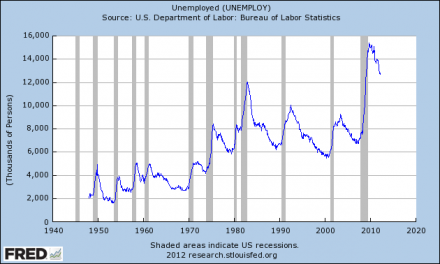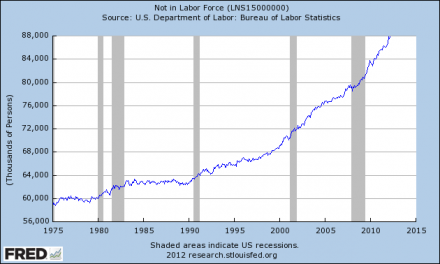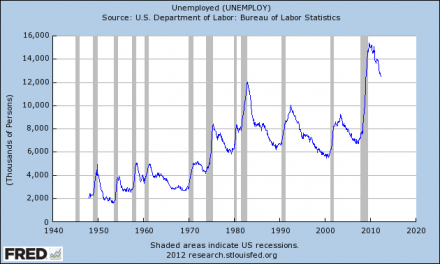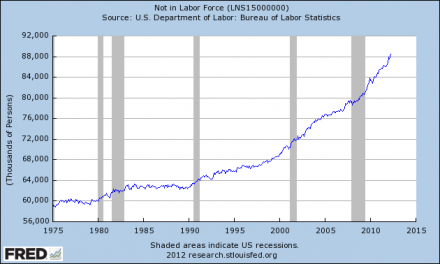Did you know that there are
100 million working age Americans that do
not get up in the morning and go to work? No wonder why it seems like
there are so many people that do not have jobs! According to the
federal government, there are
12.6 million working age Americans that
are considered to be "officially" unemployed, but there are another
87.8
million working age Americans that are not working either.
The federal
government considers those Americans to be
"not in the labor force" so
they are not included in the unemployment rate. In fact, this is one of
the key ways that the government manipulates the unemployment numbers.
The previous Bush administrations and Obama's administration would have us believe that the unemployment
rate is going down and that since the start of the last recession
about as many Americans have left the labor force as we saw during the
entire decades of the 1980s and 1990s
combined. Of
course that is a bunch of
nonsense, but that is what the government would have us believe. The truth is that the percentage
of working age Americans that are employed is just about the same right
now as it was two years ago. It was incredibly difficult to get a job
back then and it is incredibly difficult to get a job right now. So
don't believe the hype that things are getting much better. If you
still do have a good job, you might want to hold on to it tightly,
because there is not much hope that things are going to improve
significantly any time soon.
The first chart that I have posted below shows the total number of
"officially" unemployed workers in America. According to the Federal
Reserve, that number is currently
12,673,000.
This chart makes it look
like the employment picture in America is getting significantly
better...
But if you dig deeper into the numbers you quickly see that this is
not true. A lot of
those workers that were formerly classified as
"unemployed" have now been moved into the "not in labor force"
category. Since the start of the last recession, the number of
Americans not in the labor force has risen by more than 8 million
according to the Obama administration.
The total number of working age
Americans not in the labor force now stands at 87,897,000...
So when you add 12,673,000 and 87,897,000,
you get a total of 100,570,000 working age Americans that do not have jobs.
Yes, there are certainly millions of working age Americans that do not have jobs and that
do not want jobs.
But you have to be delusional to believe that there are nearly 88
million working age Americans that do not have jobs and that do not want
jobs.
The Obama administration tells us that the labor force participation rate is now the lowest it has been
since 1984.
But back then, a very large percentage of women were staying home and
raising families. The percentage of stay at home mothers has declined
steadily since then.
So the truth is that the employment statistics that we are being fed
are not portraying an accurate picture of what is really going on.
As a
CNN article
recently explained,
there are millions of Americans that say that they
would like to have a job even though they have not been "actively"
looking for one in the past four weeks. If those people were included
in the unemployment rate, it would immediately shoot up to around
11
percent...
About six million people claim they want a job, even
though they haven't looked for one in the last four weeks. If they were
to all start applying for work again, the unemployment rate would
suddenly shoot up above 11%.
If you want a much more accurate picture of what is really happening
to the employment situation in America, the key is to look at the
employment to population ratio. As I have written about
previously,
the percentage of working age Americans that have jobs is not increasing.
Let's take a look at the employment to population ratio for the last six years
for the month of March...
March 2007: 63.3%
March 2008: 62.7%
March 2009: 59.9%
March 2010: 58.5%
March 2011: 58.5%
March 2012: 58.5%
The percentage of the working age population that had jobs fell
rapidly during the recession and it has stayed very low since then.
When anyone in government tells you that "America is going back to work" s/he is lying to you.
The cold, hard reality of the matter is that
there are millions of
hard working Americans that have been sitting at home for years hoping
that a new job will come along.
Back in 2007, approximately
10 percent of all unemployed Americans had been out of work for one year or longer.
Today, that figure is above 30 percent.
The average duration of unemployment in the United States today is
about three times as long as it was back in the year 2000.
And according to a recent
Wall Street Journal article, the number of announced job cuts is actually rising again....
Also, announced jobs cuts rose 7.1% in April,
according to Challenger, Gray & Christmas, to 40,599 — and up 11.2%
from last April — another bit of evidence that the jobs market isn’t
doing well.
Economic conditions in the United States have been
steadily getting worse for quite a while, but that is not the only reason for our employment problems.
There are two other trends that I want to briefly mention.
1) A lot of jobs that used to be very labor intensive are now being
replaced by technology. Thanks to robotics, automation and computers, a
lot of big companies simply do not need as many workers these days.
Those are jobs that are never going to come back.
2) As labor has become a global commodity, millions upon millions of U.S. jobs have been sent overseas.
Today, you are not just competing for a job with your neighbors. You
are also competing with workers on the other side of the globe.
Unfortunately, it is legal to pay slave labor wages in many of those
countries. By sending our jobs out of the country, big corporations can
also avoid a whole host of rules, regulations, taxes and benefit
payments that they would be facing if they hired American workers.
So U.S. workers are at a massive competitive disadvantage. Why
should a big corporation pay 10 or 20 times more for an American worker
when they can pad their profits by exploiting cheap foreign labor?
The sad truth is that the
value that the marketplace puts on the labor of the average American worker is continually decreasing.
This is making it much more difficult to find a job and it is keeping wages down.
In the old days, pretty much any man that was a hard worker and that really wanted a good job could go out and get one.
But now all of that has changed. Back in 1950,
more than 80 percent of all men in the United States had jobs. Today,
less than 65 percent of all men in the United States have jobs.
And sadly, the vast majority of the jobs that are being lost are good jobs. As I wrote about the other day,
95 percent of the jobs lost during the recession were middle class jobs.
So how are
middle class families making it these days?
Many of them are going into tremendous amounts of debt. As a recent
CNN article
detailed, the average debt load being carried by those of us in the
bottom 95 percent of all income earners has risen dramatically over the
past several decades....
In 1983, the bottom 95% had 62 cents of debt for
every dollar they earned, according to research by two International
Monetary Fund economists. But by 2007, the ratio had soared to $1.48 of
debt for every $1 in earnings.
Unfortunately, many American families are absolutely maxed out at this point. According to one recent survey, approximately
one-third of all Americans are currently paying their bills late.
If your goal is to live a
middle class lifestyle, you need to realize that the entire way that the game is being played is changing.
In the old days, you could start out with a company as a young person
and stay with that company until you retired. If you worked hard and
you were loyal, there was a really good chance that the company would
recognize that and be loyal to you too.
These days, most companies are absolutely heartless when it comes to
their workers. The good job that you have today could be gone
tomorrow. Workers are increasingly being viewed as "liabilities", and
there is a good chance that the moment you become "expendable" to your
company you will be kicked out on the street.
That is one reason why people should consider starting
their own businesses. Working for someone else, security can
be taken away at any moment.
Unfortunately, tougher economic times are coming and things are not
going to be easy. It will be imperative to
work harder than ever, to stay flexible, and to never, ever give up.
***UPDATE***
Since the monthly jobs numbers were released on Friday I thought I would update this article to reflect the latest figures.
The federal government has announced that the unemployment rate has declined to 8.1 percent.
That certainly sounds like good news.
But knowing better, I immediately went and checked how the employment to population ratio had changed.
Well, it turns out that the employment to population ratio has fallen
once again.
That means that
a smaller percentage of working age Americans had jobs in April than in March.
The following are the figures for the past three months....
February 2012: 58.6%
March 2012: 58.5%
April 2012: 58.4%
If the percentage of people that have jobs is going down, then how can they claim that things are getting better?
The following are the two Federal Reserve charts posted above after
they have been updated with the new numbers. These charts are very
revealing.
1) There are now 12,500,000 workers that are "officially" considered to be unemployed...
2) There are now 88,419,000 Americans that are considered to be "not in the labor force". Please note that this number rose by 522,000 in just a single month!....
12,500,000 unemployed workers plus 88,419,000 Americans that are "not
in the labor force" equals 100,919,000 working age Americans that do
not have jobs.
That number continues to climb at a very rapid pace.







